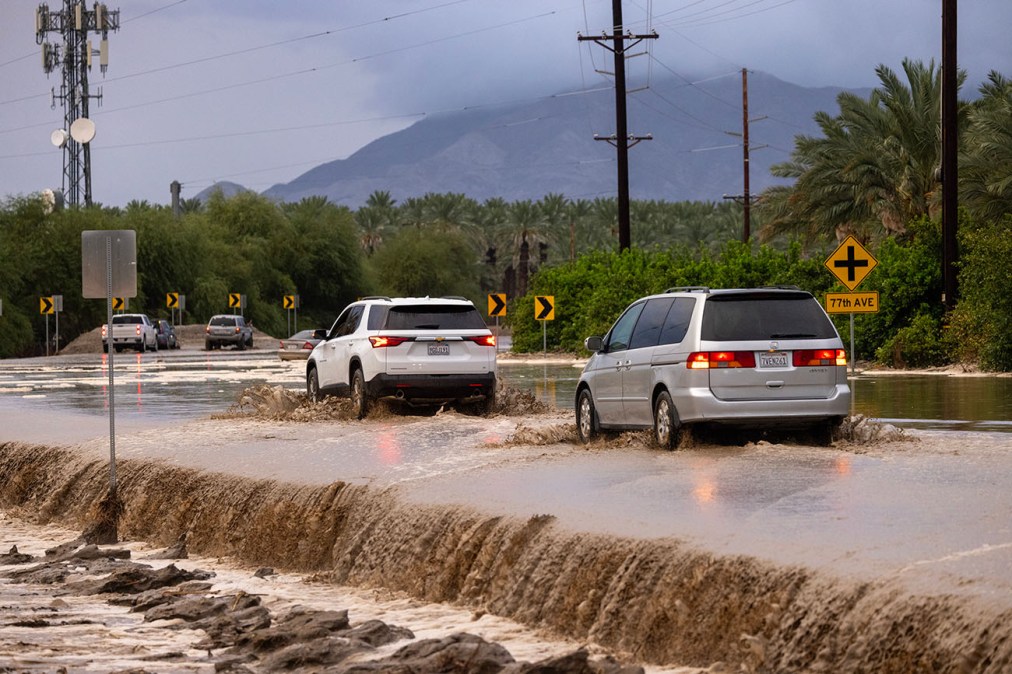Is California ready for another extreme storm season?

For decades, California honed its state preparedness, emergency services and innovations in technology to quickly and effectively respond to wildfires, the state’s most frequent natural disaster. But at the end of last year’s winter storm season, after a dozen atmospheric rivers had soaked all 58 counties, the Governor’s Office of Emergency Services and other state agencies realized they’d been underprepared.
“Wildfires happen in one county, maybe two, and, if it’s a multimillion acre fire, maybe three, but not in all 58,” Diana Crofts-Pelayo, assistant director of crisis communications for CalOES, said of the 2022-2023 storm season in which 12 atmospheric rivers hit the state after decades of drought. “These atmospheric rivers touched nearly every single community in the entire state, so that was something new.”
Atmospheric rivers are relatively long, narrow regions – “like rivers in the sky,” according to the National Oceanic and Atmospheric Administration – that transport most of the water vapor outside of the tropics. Experts at NOAA’s Climate Prediction Center claim there is a 35% chance that a historically strong El Nino, an oceanic and atmospheric phenomenon, will hit the United States, specifically California, this winter, bringing another bout of unprecedented precipitation to the normally dry state.
At a virtual storm safety briefing last week, with media professionals and officials from the Department of Insurance, CalOES and NOAA, officials said the 2023-24 rainy season in California will rival the intense winter rain seasons of decades past, including possible heavy snows early in the season with warmer rains later in the season, putting more than seven million Californians at risk of flooding.
In response to the prediction of an intense and possibly historic winter storm season, Crofts-Pelayo said, the emergency office is taking a more proactive approach to storm safety and preparedness this year, including by hosting a citizens’ awareness campaign, repurposing emergency response technology originally intended for wildfires and promoting the state’s emergency alert system.
Fighting flooding with wildfire technology
Though last year’s atmospheric rivers struck each county in California – from rural to urban areas, in valley and desert communities, in mountain regions and along the coast – Crofts-Pelayo said each region was affected in a different way, forcing the agency to craft tailored responses.
“In some areas, it was heavy rain or heavy flooding, and in other areas it was deep, deep snow,” she said. “So we needed to ensure that communities could stay safe from the wide range of impacts.”
Because wildfires are common across the state, California has a deep bench of disaster technology that can be repurposed for winter storms, including its aerial surveillance cameras.
“This awesome camera on the plane [can] survey the entire state and could tell us where there were impacts of flooding or might have experienced flooding the next day after a heavy rainstorm,” Crofts-Pelayo said. “And so, we were able to map and predict where certain populations could possibly be hit more than others.”
The emergency response agency can use aerial imagery to determine the best course of action: whether to send fire engines, swift water rescue teams or road-clearing crews.
“Being able to kind of deploy that at a moment’s notice, that’s kind of an internal back-end technology that we have that probably a lot of Californians don’t see,” she said.
“We oftentimes say disasters are local — they happen first in the community. And so it is really incumbent upon those local governments to help their communities,” she said. “Then if that emergency or disaster becomes too large for them, that’s where we step in. And then if it’s too large for us, that’s where the federal government kind of steps in as well.”
‘Get water where it can do the most good’
Forecasting tools from NOAA also help the California Department of Water Resources better manage the deluge of rain the state receives during the storm season, through strengthening levees and preparing reservoirs to safely capture water, said Michael Anderson, a state climatologist.
Anderson focuses on providing water-related information to emergency response agencies that support the state during extreme weather events. He said his department, along with the U.S. Bureau of Reclamation, which manages water and power in the West, works to ensure California’s reservoirs have enough flood space available to accommodate a second year of flood conditions — and to water for future droughts.
“You’re always trying to get water where it can do the most good,” Anderson said.
He said his department works with local water agencies to release excess water downstream to make room in the state’s reservoirs for the next storm – a technique called diversion, which starts at the beginning of each October.
“That space [in the reservoir] gets bigger until you get to this time of year,” Anderson said. “It’s really important to have all this early coordination communication, because you don’t want to be trying to sort that out when rain is pouring down. You want to have all that ready to go while it’s still these beautiful sunny days.”
Gov. Gavin Newsom’s most recent budget includes more than $430 million for statewide flood response and projects to protect communities from future flooding, including the recently completed Lower Elkhorn Basin Levee Setback project in Sacramento, designed to allow increased flow from the Sacramento River into the Yolo Bypass during high water flow events, reducing flood risk for 780,000 people.
Anderson said the Department of Water Resources is also helping local entities prepare for the threat of a second straight year of flood conditions — with funding, flood fight training and continued material support across the state. The department is starting this storm season with more flood-fighting materials on hand than last year, including 2.4 million more sandbags.
Anderson said he’s confident about the efforts the state has made to prepare for the storm season using reputable forecasting tools, but that storms are unpredictable.
“Mother Nature has no obligation to stay within the limits,” Anderson said.
An ounce of prevention
Flood insurance is also something Californians need to consider ahead of the coming rainy season, said Yasmin Ortega, a spokesperson for the California Department of Insurance.
“Generally speaking, a [standard] homeowner’s policy does not cover flood, mudslides or debris flow,” Ortega said during the storm safety media briefing, adding that less than 2% of California households hold flood insurance.
The liability policies that California homeowners are required to carry don’t cover flooding or related damage like tree branches falling on vehicles due to high winds or heavy rain. And the FAIR Plan, insurance California offers to residents who can’t get coverage from private insurers, only covers fire damage.
“That’s why we encourage people to seek that coverage and make sure that they have it when they need it,” Ortega said.
She added that if flood damage is not covered under their current policies, residents can apply for coverage through FEMA’s National Flood Insurance Program — or from a private insurer, though that’s proving increasingly difficult as more insurers flee the state due to the increasing number of natural disasters.
“The Department of Insurance through the insurance commissioner are looking at policy solutions to be able to cover more people and make sure that people have access to insurance” Ortega said of the predicament.
‘Have a go-bag’
As the winter storm season approaches — last year’s atmospheric rivers hit California towards the end of December — the state’s emergency services and insurance departments launch an informational campaign to spread awareness of the severity of the storms that experts predict will hit the state, Diana Crofts-Pelayo said.
“People have to take individual responsibility to ensure that they not only have a go-bag, but also talk [to] their family members about what evacuation actually means,” Crofts-Pelayo said.
She said residents should create evacuation plans with family members inside and outside their households and account for important documents, medications and other necessities in case they need to flee.
“That’s why it’s really important for homeowners, and just Californians in general, to understand and take inventory of all of their belongings before the storm season,” Crofts-Pelayo said.
Aerial surveillance, combined with intelligence from the National Weather Service, also allows CalOES to push statewide and regional alerts to residents through Listos California, a project that aims to give residents a few hours’ notice before atmospheric rivers land. The alerts direct people to stay indoors or to evacuate quickly to stay safe.
“We were on planes to try to predict how many atmospheric rivers were going to actually be coming our way,” Crofts-Pelayo said, “to properly inform our local communities to push those alerts out.”
Meaning “Ready California” in Spanish, the initiative connects residents to emergency preparedness information, disaster recovery resources and provides a sign-up form for emergency alerts.
“We have this atmospheric river under our belt, this last series of atmospheric rivers under our belt,” Crofts-Pelayo said, “and if this is another really intense storm season, we hope that we will be ready.”





